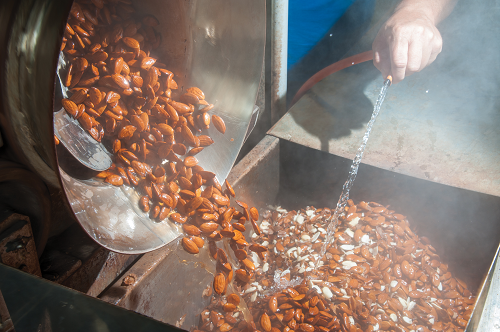Moisture control in almond processing
The Almond is an edible nut which can be eaten whole or processed for inclusion in other food products. The United States is the largest producer of almonds in the world, with production being centred in the California area where the climate is conducive to its successful growth. Other top producing countries include Australia and the Mediterranean area of Europe, with a total world production of nearly 3 million tonnes per year. Almond trees are harvested from late summer, which is when the nuts are sent for processing, typically arriving hulled and ready for further treatment.
Almond Processing
Almonds are a food product so therefore require a high degree of quality control to ensure that the nuts are suitable for human consumption. Continuous quality control checks take place throughout various stages of production, and an important part of these checks is to ensure that the moisture content of the almonds is at the correct level for the relevant part of the process.
Natural almonds arrive at the processing plant with an existing moisture content of approximately 4%. They are initially passed through a system which removes any unwanted material before being pasteurised for about 8 hours using steam at approximately 93°C to kill any micro-organisms. The moisture level is then checked to ensure that the nuts are at the correct moisture percentage before being passed forward for the next part of the process.
If the almonds are going to be sold whole as a “raw” product, they are moved through to another part of the plant where they are checked for quality and then packaged.
Almonds that are going to be further processed are moved through to a blanching process which uses steam to loosen and remove the skins leaving the white almond meat exposed. The very nature of the pasteurising and blanching processes adds moisture to the almonds, so once de-skinned the almond meats need to be dried to reach the recommended moisture target for the next part of the process.
The moisture level of the almonds is then rechecked after drying and recorded for quality control purposes. The almonds are then sliced, slivered, ground or sent for inclusion into other products.

Contact us to find out more!
Why Moisture is Important
If the almonds are going to be packaged whole as a “raw” product, then they need to achieve a final moisture target of 5.2% to 5.9%.
However, if the nuts are going to be further processed such as sliced, slivered or ground, then they need to reach a moisture target of 6.5% to 7.3%. The moisture content is critical to ensure that packaged or stored almonds do not deteriorate and that processed almonds have minimum breakage or waste, ensuring that the final products are of the best quality.
The Benefit of Installing Microwave Moisture Sensors
Installation of microwave moisture sensors at different stages throughout the process ensures that the almonds are at the correct moisture level for each stage. The process is also automated reducing the need for manual sampling. Further benefits include:
- Dryers can be used more efficiently reducing energy costs, avoiding over or under drying the product
- Dryer temperature can be automatically adjusted allowing drying at the correct rate to avoid product damage
- Improved and consistent final product
- Reduction in level of spoilt/wasted materials
- Increased confidence that stored almonds will not deteriorate
- The sensors are not affected by dust or colour
Recommended Installation
Installation of moisture sensors is simple and can be included in either new or existing plant systems. Each installation may be different and will depend on the plant’s specific requirements. However, the moisture sensor should always be installed so that the flow of material across the ceramic faceplate is consistent and of a good depth.
Almonds that are blanched and dried should have a moisture sensor installed ideally after both processes but as a minimum after the dryer. This enables real-time readings to be sent directly back to the plant control system allowing the dryer temperature or drying time to be immediately adjusted. This ensures that the material exiting the dryer is always at the correct moisture level and eliminates the need to wait for oven tests. There is also a reduction in the amount of substandard or wasted product caused by the time delay between periodic sampling and subsequent dryer adjustment.
The addition of a moisture sensor installed in the neck or underneath the bin or hopper where the “raw” or processed almonds are released for packing ensures that the nuts are at the correct moisture level enabling the Quality Control Manager to be confident that the almonds will not deteriorate.
Hydronix Moisture Sensors
Hydronix has a range of sensors that are designed for flowing bulk materials such as nuts, grains and pulses. For installation either in or underneath the neck of the bin, a Hydro-Probe XT is recommended. For installation into ducting or a screw conveyor, the flush-mounted Hydro-Mix XT sensor provides an excellent solution.


